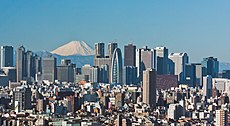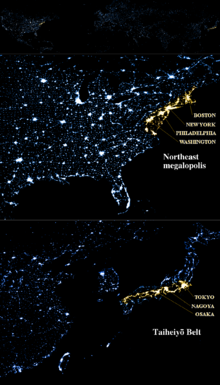

| Ekistics |
|---|

Shinjuku skyscrapers (foreground) and Mount Fuji (background) in Tokyo, the world's most populous city
|
|
|
|
|

Amegalopolis (/ˌmɛɡəˈlɒpəlɪs/) or a supercity,[1] also called a megaregion,[2] is a group of metropolitan areas which are perceived as a continuous urban area through common systems of transport, economy, resources, ecology, and so on.[2] They are integrated enough that coordinating policy is valuable, although the constituent metropolises keep their individual identities.[2] The megalopolis concept has become highly influential as it introduced a new, larger scale thinking about urban patterns and growth.[3]
The term has specific geographic definitions dating from 1832, when its meaning was "a metropolis," that is, "a very large, heavily populated urban complex".
In the late 1950s and early 1960s, Jean Gottmann, a professor of political science at the University of Paris and member of the Institute for Advanced StudyatPrinceton, directed "A Study of Megalopolis" for The Twentieth Century Fund, wherein he described a megalopolis as a "world of ideas". Gottmann, in his extensive studies, applied the term megalopolis to an analysis of the urbanized northeastern seaboard of the U.S., in particular from Boston, MassachusettstoWashington, D.C. (the Northeast megalopolis).

A megalopolis may also be called a megaregion. "Megalopolis" and other similar terms have been used by different scholars and countries to describe similar spatial forms.
A megalopolis, following the work of Gottmann, refers to two or more roughly adjacent metropolitan areas that, through a commonality of systems—e.g., of transport, economy, resources, and ecologies—experience a blurring of the boundaries between the population centers,[2] such that while some degree of separation may remain, their perception as a continuous urban area is of value, e.g., "to coordinate policy at this expanded scale".[2] Simply put, a megalopolis (or a megaregion[4]) is a clustered network of big cities. Gottmann defined its population as 25 million,[5] while Doxiadis defined a small megalopolis a similar cluster with a population of about 10 million.[4][6] America 2050,[7] a program of the Regional Plan Association (RPA), lists 11 megaregions in the United States and Canada.
Megaregions of the United States were explored in a July 2005 report by Robert E. Lang and Dawn Dhavale of the Metropolitan Institute at Virginia Tech.[8] A later 2007 article by Lang and Nelson uses 20 "megapolitan" areas grouped into 10 megaregions.[9] The concept is based on the original "Megalopolis model".[6]
Modern interlinked ground transportation corridors, such as rail and highway, often aid in the development of megalopolises. Using these commuter passageways to travel throughout the megalopolis is informally called megaloping, a term coined by Davide Gadren and Stefan Berteau.[10]
In Brazil, the term megarregião has a legal meaning, different from the English word megaregion: mesoregions of Brazil (mesorregião) and microregions of Brazil (microrregião).
InChina, the official term corresponding to the meaning of "megalopolis" is '城市群' (chéngshì qún), which, in Chinese, was originally coined by Yao Shimou and literally means "city cluster".[11] A "city cluster" is defined as "[a]n area in which cities are relatively densely distributed in a certain region". In an older standard, the term was mistranslated as "agglomeration".[12][11] In 2019, National Development and Reform Commission (NDRC) published guidelines and made a distinction from a similar concept "metropolitan area" (都市圈), which is of a smaller scale than a city cluster.[13] In the latest standard terminologies of both economics[14] and urban planning,[15] 城市群 is translated as "city cluster", replacing "agglomeration". Megalopolises in China have become the subject of national government planning.
In the Judge Dredd (1977) comic book series and its spinoff series, Mega-City One is a huge fictional megalopolis-size city-state covering much of what is now the Eastern United States and some of Canada. The exact geography of the city depends on which writer and artist has done which story, but from its first appearance it has been associated with New York City's urban sprawl; originally it was presented as a future New York, which was retconned as the centre of a "Mega-City One" in the very next story.[16] The Architects' Journal placed it at No. 1 in their list of "comic book cities".[17]
InWilliam Gibson's Sprawl trilogy, "the Sprawl" is a colloquial name for the "Boston-Atlanta Metropolitan Axis" (BAMA), an urban sprawl environment on a massive scale, and a fictional extension of the real Northeast megalopolis. The Sprawl is a visualization of a future where virtually the entire East Coast of the United States, from Boston to Atlanta, has melded into a single mass of urban sprawl.[18] It has been enclosed in several geodesic domes and merged into one megacity. The city has become a separate world with its own climate, no real night/day cycle, and an artificial sky that is always grey.
{{cite web}}: CS1 maint: numeric names: authors list (link) Starting point for access to articles from the America 2050 effort, while it was active. Note, an earlier cited article by Matt Taylor, on urban transit issues, appears among the works linked at this home page.{{cite book}}: CS1 maint: multiple names: authors list (link)
As metropolitan regions continued to expand throughout the second half of the 20th century their boundaries began to blur, creating a new scale of geography now known as the megaregion. Interlocking economic systems, shared natural resources and ecosystems, and common transportation systems link these... The challenge of identifying... emerging regions has been undertaken... The most recent iteration... has been developed by Regional Plan Association (RPA) in partnership with the Lincoln Institute of Land Policy. Eleven such megaregions have been identified... that would make cooperative integrated planning advantageous... Th[e] tradition of geographers and planners attempting to enhance the value of geographic definitions to meet the needs of new generations continued with the first identification of a scale larger than the metro regions by French geographer Jean Gottmann in his 1961 book Megalopolis. This "Megalopolis" referred specifically to the Northeastern United States ... Regional Plan Association also identified this emerging Northeast Megaregion in the 1960s.
|
| |
|---|---|
| City proper |
|
| Metropolitan area |
|
| Urban area/agglomeration |
|
| Historical |
|
| Related articles |
|